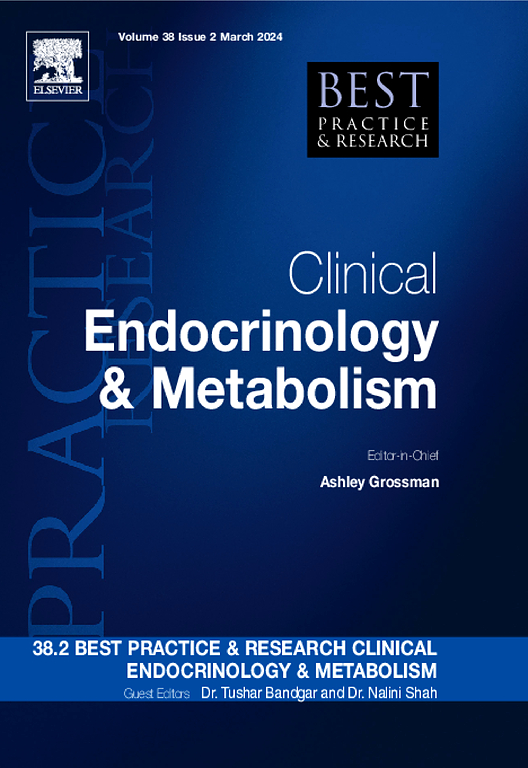Persistence and Recurrence of Primary Hyperparathyroidism
IF 6.1
1区 医学
Q1 ENDOCRINOLOGY & METABOLISM
Best practice & research. Clinical endocrinology & metabolism
Pub Date : 2025-03-01
DOI:10.1016/j.beem.2025.101986
引用次数: 0
Abstract
Persistent and recurrent primary hyperparathyroidism (PHPT) represent significant challenges in the management of PHPT. Persistent PHPT is defined as persistence of hypercalcemia following parathyroidectomy (PTX) or the recurrence of hypercalcemia within the first 6 months following surgery. Recurrent PHPT is defined as recurrence of hypercalcemia after 6 months following PTX and requires normalization of serum calcium prior to the recurrence. These conditions are often attributed to missed or ectopic glands, multiglandular disease, surgeon inexperience, or rare causes such as parathyromatosis and parathyroid carcinoma. Diagnosis requires a detailed biochemical evaluation, imaging studies, and exclusion of other causes of hypercalcemia as well as secondary causes of hyperparathyroidism. Preoperative imaging modalities, including neck ultrasound, SPECT-CT with 99m Tc-sestamibi scan, 4D-CT, 18F-Fluorocholine PET/CT, and PET/MRI are helpful in localizing abnormal parathyroid glands in cases requiring repeat surgery. Repeat surgery is associated with higher risk and requires an experienced surgeon. When surgery is not indicated or possible, medical management with cinacalcet and antiresorptive therapies may be considered. This review highlights the etiology, diagnostic approaches, and management strategies for persistent and recurrent PHPT, emphasizing the importance of multidisciplinary care in order to optimize outcomes.
原发性甲状旁腺功能亢进的持续和复发。
持续性和复发性原发性甲状旁腺功能亢进(PHPT)是PHPT治疗的重大挑战。持续性PHPT定义为甲状旁腺切除术(PTX)后持续高钙血症或手术后6个月内高钙血症复发。复发性PHPT定义为PTX后6个月出现高钙血症复发,且在复发前需要血钙正常化。这些情况通常归因于腺体缺失或异位,多腺体疾病,外科医生缺乏经验,或罕见的原因,如甲状旁腺瘤病和甲状旁腺癌。诊断需要详细的生化评估,影像学检查,排除其他导致高钙血症的原因以及甲状旁腺功能亢进的继发原因。术前影像学检查,包括颈部超声、SPECT-CT加99m Tc-sestamibi扫描、4D-CT、18f -氟胆碱PET/CT和PET/MRI,有助于在需要重复手术的情况下定位异常甲状旁腺。重复手术风险较高,需要经验丰富的外科医生。当不需要手术或不可能手术时,可以考虑使用cinacalcet和抗吸收治疗。这篇综述强调了持续性和复发性PHPT的病因、诊断方法和管理策略,强调了多学科治疗的重要性,以优化结果。
本文章由计算机程序翻译,如有差异,请以英文原文为准。
求助全文
约1分钟内获得全文
求助全文
来源期刊
CiteScore
11.90
自引率
0.00%
发文量
77
审稿时长
6-12 weeks
期刊介绍:
Best Practice & Research Clinical Endocrinology & Metabolism is a serial publication that integrates the latest original research findings into evidence-based review articles. These articles aim to address key clinical issues related to diagnosis, treatment, and patient management.
Each issue adopts a problem-oriented approach, focusing on key questions and clearly outlining what is known while identifying areas for future research. Practical management strategies are described to facilitate application to individual patients. The series targets physicians in practice or training.

 求助内容:
求助内容: 应助结果提醒方式:
应助结果提醒方式:


